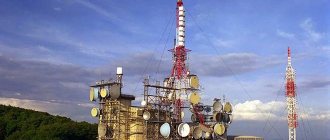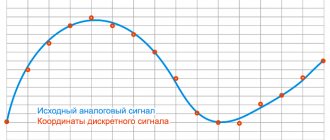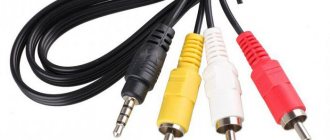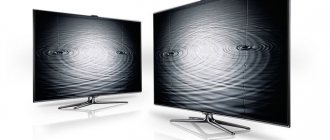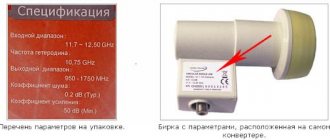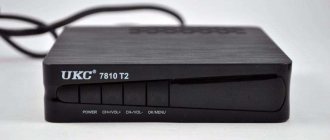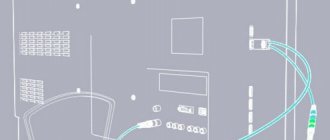Thanks to the dynamic development of television broadcasting in the modern world, there is probably no person who has not encountered antennas. In order to watch their favorite TV programs in the best quality, the user needs to connect an antenna to their receiving equipment. And here the question arises: which antenna to choose, active or passive? In this article we will consider in as much detail as possible the features of each antenna, as well as their scope of application. But first of all, it is necessary to give a detailed definition of the term “antenna” itself and briefly describe the history of its creation.
An antenna is a special device whose main task is to receive or emit radio waves. It converts electrical current fluctuations into radio waves or vice versa. As can be seen from the definition, antennas can operate for reception, transmission, or reception-transmission. The simplest antenna operation scheme is as follows: a television or radio device produces a signal, which is amplified and transmitted to the transmitting antenna. The antenna, in turn, distributes this signal in the form of radio waves. During the propagation process, the waves reach receiving antennas, which record them and transmit them for processing with subsequent output to end devices in the format of the original signal. Each stage of antenna operation may be accompanied by certain interference arising from other radiation sources or terrain features.
The creator of antennas was the famous German physicist Heinrich Hertz. It was he who, in 1888, made the first such device to confirm the presence of electromagnetic waves. Of course, since that time, antennas have changed significantly both externally and functionally. Today we will only touch on the classification according to the level of antenna activity, although there are quite a large number of different types and types of antennas.
Outdoor antennas
External receiving devices are distinguished by high power, which is provided by a special design, and in some modifications, built-in amplifiers. Outdoor antennas receive signals from a source at a distance of up to 50 kilometers.
Possible interference from obstacles located in the signal path should be taken into account. Metal structures, buildings, and structures reflect or distort waves. Therefore, most experts recommend purchasing equipment with built-in amplifiers. The top external antennas include 2 models.
Important! Powering the active antenna from the t2 receiver reduces the life of the power supply. The load on the set-top box doubles, and with a long cable length triples
Remo "Kolibri-A-DX Deluxe"
The signal receiver is placed on a mast, which is included in the delivery package. This configuration improves channel acceptance. The built-in amplifier helps to receive TV signals even at considerable distances from towers. Thanks to Remo’s successful design, Kolibri-A-DX Deluxe picks up digital signals even in areas where there are no towers within line of sight.
In positive reviews, buyers note stable reception and good signal quality. The device is easy to set up. Assembly and installation takes 10-30 minutes. The external structure is protected by powder coating, which provides protection against rust and exposure to chemicals.
The delivery set includes an external power adapter and a connection cable (6 meters long). Some customers have had problems adjusting the external amplifier.
Remo "Dvina-DX"
The powerful antenna ensures reliable signal reception up to 50 kilometers. The device is equipped with a built-in amplifier and a 12-volt power adapter. The main advantages of the TV antenna are excellent reception, low price, reliability, and ease of use.
All components are made of high quality materials. The aluminum support rod is lightweight and durable. External elements that receive signals are treated with an anti-corrosion coating. The fastener securely fixes the TV antenna. The disadvantages include a rather complicated installation, as well as the need for adjustments for high-quality channel reception.
The most powerful antenna for DVB-T2 with amplifier
If you live far from a digital communications tower, then you need to buy a very powerful antenna with a good amplifier. In this case, you will get a good clear picture and pleasant sound while watching.
Powerful antennas should be purchased if you live in a very small locality - otherwise there is no practical use for powerful amplification (you can buy a less powerful device, but the picture will still be of high quality). Below we will look at 2 powerful performance DVB-T2 antennas.
Strong 21.1-60V Super with Alcad amplifier
A powerful outdoor antenna capable of amplifying the signal by 45 decibels. Capable of receiving and modulating a signal at a distance of up to 70 kilometers from the tower. Effectively suppresses external noise and distortion. The device is made on an aluminum base and is recommended to be installed on the roof of a building. It is lightweight and highly stable in strong winds. The average price on the Russian market is 2,500 rubles.
Triton XL-LF with Breeze amplifier
The best digital DVB T2 antenna with amplifier available on the domestic market. When connecting the Breeze amplifier, the gain level is 55 decibels, which allows you to get a stable, high-quality signal even at a distance of 90-100 km to a radio tower. The body is made of aluminum, and to obtain the maximum level of reception it is recommended to install the antenna on the roof of the house. The only major drawback of the device is its price (4,200 rubles).
How to properly amplify digital TV
Gain selection
Determine what level of TV signal amplification should be. The territory where DVB-T2 reception is possible is divided into 3 conventional zones:
- Close distance to the repeater (from hundreds of meters to 5–10 km). At such a distance, an amplifier is not needed; a high-quality passive antenna is sufficient.
- Average distance (15–30 km). Here the device will already be useful, but the coefficient must be selected so that in the end the signal power does not exceed the threshold value. If the TV signal is too strong, the TV or receiver will not be able to interpret it correctly and reception will not be possible.
- Long distance (30 km or more). There is no need to worry about excessive signal strength here. However, adjusting the gain will also be useful.
Also consider the gain of the antenna you are using. You need to proceed from the rule: the amplifier coefficient must be higher than that of the antenna, otherwise the device is useless.
You can find out the value in two ways:
Gain adjustment is carried out according to the following scheme:
- Connect the antenna at a minimum distance from the TV. If the reception is normal, then the minimum required parameters will become clear from the value of its own gain.
- Connect the antenna, located in its normal place, through the amplifier. The coefficient should be slightly greater than that of the antenna itself. If transmissions are received without interference, then no other steps are needed.
- If the TV or receiver indicates that there is no signal, increase the gain until normal reception begins.
- If digital channels stop showing, although there is a signal, or video from several programs has begun to overlap on the screen, the gain is too high and needs to be reduced.
Good video instructions for selection:
Amplifier connection
When choosing an installation location, follow the rule: the closer to the antenna, the better.
Ideally, you should use an active antenna, where the amplification unit is built into it itself. If this is not possible, place the amplifier where the antenna cable enters the room, and then extend the route to the TV.
If there are several TV receivers, intersect the wires at right angles. This will reduce the interference of cables with each other. As a result, the signal quality will improve.
Previous AntennaWe make a digital antenna from ordinary beer cans Next AntennaThe 10 best antennas for receiving terrestrial digital TV
In the amateur radio community and among professional installers of television equipment, there is ongoing debate about which antenna to use - active or passive. At a short distance from the tower, the answer to the question is obvious - passive. Why do you need an amplifier if everything is already picked up? But at the border of reliable reception, a dilemma appears: either use an expensive large “digital” passive antenna without an amplifier, or use a relatively simple inexpensive antenna, but with an amplifier. Both from a technical and economic point of view, we consider the second option more appropriate and here’s why...
First, let's determine whether you need an antenna amplifier at all. This can be done using a DVB-T2 set-top box, or a TV if it itself receives digital. If the signal level does not rise to more than 50-60%, then an amplifier is necessary and you will have to choose one from a large number on the market. How to do it?
First of all, let's pay attention to the main parameters of antenna amplifiers, on the basis of which we will conduct a comparative analysis and selection of candidates:
- Noise figure;
- Gain;
- Dynamic range (resistance to interference outside the operating range);
- Bandwidth;
- Amplifier stability (or instability, i.e. tendency to self-excitation)
One of the main problems of the well-known SWA plate amplifiers of the previous generation, which are still used in conjunction with the Polish antenna, is their extreme instability. When used in conjunction with a digital tuner, the latter often “goes into the astral plane” from the action of powerful interference from the generating amplifier and reception becomes impossible. As you know, the real sensitivity of an amplifier is determined primarily by the noise figure, and an infinite increase in gain does not bring results, since noise increases along with the signal. However, the average buyer constantly asks for a “more powerful amplifier” on the market. As a result, amplifiers of the SWA line appeared on sale with a gain of up to 45 dB and a noise factor of about 3 dB. These amplifiers are extremely unstable and have a very low dynamic range, i.e. “shut up” by relatively low-power extraneous interference. Currently, they are all completely discredited and outdated. Fortunately, the situation has changed recently; new, inexpensive amplifiers have appeared, both in the SWA line and in the PAE/ALN line, with transistors using SiGe:C technology, with a very low noise figure and high stability.
Therefore, at this point in time, we recommend for long-distance reception of digital television to use an exclusively active antenna with a new generation “plate” amplifier installed directly on the antenna, and the following arguments can be given in favor of this:
- Most of the digital receivers are not designed for long-distance reception, but for cable and public television systems and have not at all outstanding parameters. Modern tuners based on the MxL608 chip have a noise figure of ~4.2 dB, with a maximum sensitivity of up to -81.5 dBm. This limiting figure, the real sensitivity of the system is less by the amount of losses in the passive antenna feeder. The use of a new generation antenna amplifier with a noise figure of <1 dB makes it possible to level out losses in the feeder and increase the overall sensitivity of the system to -84.8 dBm, even regardless of the quality of the tuner. This additional 3.3 dB makes it possible to either receive a signal where reception without an amplifier is impossible, or, with stable reception, reduce the dimensions of the antenna by approximately 2 times and save significantly on this. What is dBm and how to understand these negative numbers, see here.
- A modern home has a large amount of high-frequency interference from all kinds of household and digital equipment. This interference inevitably penetrates the digital tuner input, worsening the signal-to-noise ratio. The use of a high-quality antenna LNA eliminates this problem.
- Set-top boxes and TVs that have a digital T2 tuner have a built-in 5V antenna power supply with protection against short circuits and overcurrents. You don’t need any external injectors with a separate power supply like the Polish antenna.
- Having a gain margin, it is relatively easy to split the signal to several TVs using simple cheap broadband splitters, which cannot be done using a passive antenna.
When choosing a good new generation low-noise antenna amplifier, in order not to end up with an old and low-quality one, you should be guided by the following criteria:
- The noise figure (Noise figure) of the amplifier should be no more than 2dB; amplifiers based on SiGe:C transistors have Ksh < 1 dB and are even more preferable. In this case, the amplifier must operate together with the antenna at an SWR of no more than two at the input, i.e. with a high quality antenna. Otherwise, a high SWR leads to mismatch losses, a decrease in SNR, which corresponds to a decrease in the noise figure of the entire system. The stability of the amplifier at high SWR also decreases;
- For stable operation with a good dynamic range, the LNA gain should not exceed 20-25 dB. Amplifiers with a Ku of 35-45dB are highly likely to self-excite and make you nervous;
- It is highly desirable that the amplifier bandwidth be limited to the UHF range. This increases its stability and reduces the likelihood of being clogged with powerful out-of-band interference;
- Amplifiers with a screen and connection via an F-connector are more preferable;
- The amplifier must be powered from 5V;
For antennas with an output impedance of 75 Ohms (for example, a log-periodic antenna), it is better to use a barrel-shaped pass-through amplifier. It must be selected based on the same criteria and located as close to the antenna as possible. The plate amplifier has an input impedance of 300 ohms. Most antennas for digital television presented on our website have an output impedance of 300 Ohms and are designed to work together with plate amplifiers. If there is no need for an amplifier, then instead of it, a 4:1 (300/75) matching board, for example SWA0 (SWA69), is installed together with such antennas.
Oldfags will say that even 30 years ago it was possible to assemble a good low-noise amplifier yourself, for example, using a KT3101A-2 transistor, and many fans of long-distance television reception did so. But now it’s just easier and cheaper to buy a ready-made good amplifier, but assembling it yourself is a completely different story (see link [4] below)…
Related links:
- ;
- . The right technology, at the right time;
- for Polish antennas;
- with a noise figure of 0.6 ... 0.8 dB on the SPF5043Z chip from DL2KQ;
- Kharchenko antenna for DVB-T2, designed to work in conjunction with an antenna amplifier;
- Double Kharchenko antenna for digital television;
- DIY broadband wave channel for digital television;
- VK()
- Facebook()
- Comments (5)
Comments
Petr89 09/19/2019 10:26 Everything described about passive and active antennas is applicable only to flat terrain; for long-range reception and in difficult conditions, as well as in terrain with elevation changes, there is nothing better than the wave channel and alcade 200. Alkad should be positioned as close to the antenna as possible. Kaluga region, Maloyaroslavets district, SNT Porechye is not far from the tower, but the forest and terrain greatly reduce the level of both 3g/4g frequencies and digital TV. It has gotten to the point that at a distance of 1.5 - 2 km, the Megafon tower is not able to provide not only a stable Internet, but even a voice without interruptions.
Quote
Stepan 05/01/2020 10:54 Can anyone tell me: you need to make an active splitter for 4 TVs, but not from the antenna, but from the cable network. Now the amplifier + passive divider circuit is included for 4 TVs. The problem is this: you need an amplifier stage circuit with an input resistance of 300 Ohms, so that when four inputs are connected in parallel, the total resistance is 75 Ohms. Is it possible to connect this way?
Quote
3G-Aerial admin 05/01/2020 22:20 What is the point in this scheme? First, the passive adder/divider maintains end-to-end matching. If we load all its inputs/outputs into 75 Ohms, then from whichever input/output we measure, we will get 75 Ohms. Here, on the feeder side, we will see 75 Ohms (4x300 in parallel), but on the side of any of the amplifier inputs, it’s not 300 (3x300 + 75 in parallel). There is a mismatch and the tendency of such a circuit to self-excite. Secondly, the noise increases proportionally. At each input of the amplifier, four transistors make noise instead of one. Thirdly, let's return to the first question. In the amplifier + passive divider circuit, the amplifier more than covers any losses of the passive divider, and is free from the disadvantages “firstly” and “secondly”. What is the meaning of a circuit of 4 amplifiers then?
Quote
Stepan 05/01/2020 23:27 Yes, you are right about the mismatch in resistance, my proposal is wrong. But I don’t understand why the noise will increase fourfold? Maybe then we can make a system according to the scheme: amplifier + divider for 4 TVs + another amplifier at each output of the divider?
Quote
Stepan 05/02/2020 18:12 Can you tell me where I can read about making transformers for a TV splitter? I am interested in the design and brands/sizes of ferrites. Or maybe there are options for printed splitters?
Quote
Update list of comments
Add a comment
Comments from anonymous people (not registered site users) are pre-moderated. Moderation does not take place in real time and there may be a delay. We ask particularly impatient anonymous people not to publish the same post in a row. In this case, the post may be rejected by the moderator. Messages from disposable and non-existent emails are also deleted. The site has a forum and comments on social networks, where there are many more opportunities for communication.
©3G-Aerial
Antenna options for digital TV
Collective
In dense urban areas, a radio signal, especially in the decimeter range, spreads unpredictably and there are not many places for high-quality reception. Therefore, for buildings with a height of more than 5 floors, it is better to use collective antennas.
The signal is received in them, and then amplified and transmitted through a distribution device via cables to each apartment.
Of course, the overall infrastructure has both strengths and weaknesses:
| + | — |
| Signal quality. Each device is installed by masters and equipped with an amplifier, so excellent results are guaranteed | Difficult to install. It will not be possible to install or configure it without experienced installers - there are many pitfalls here |
| No need to configure. Residents do not need to purchase an individual one and deal with installation and debugging | High price. The only correct way is to agree with your neighbors to share the installation |
| Regular maintenance. The management company or organization of homeowners is responsible for the operation of the structure. The subscriber just needs to file a complaint about poor quality work, and the service organization itself will correct the shortcomings. | Subscription fee. Requires installation and maintenance costs, so access to it is provided on a fee basis. Because of the latter circumstance, subscribers often enter into contracts with cable broadcasting operators: if you pay anyway, why not get additionally those channels that may not be available on the air? |
But in general, we recommend this option as the most versatile for multi-story buildings.
Outdoor individual
In a private house and small towns with individual housing developments, residents, as a rule, do not manage to get organized and buy a common house antenna. For such cases, manufacturers have provided individual external receiving devices.
They catch the UHF from the nearest television tower. You can assemble them yourself with minimal knowledge of radio engineering. Relatively cheap (from 500 rubles), do not require payment for access. True, the quality of the signal greatly depends on the location and spatial orientation.
Indoor
Suitable for those who want to watch TV without connecting to a cable or shared antenna. They are a round frame with or without an amplifier.
They work well only if the repeater is located nearby (ideally in line of sight) - read about this below.
Which is better - indoor or outdoor antenna?
Indoor! Outdoor!
Satellite dishes
A satellite dish is the best choice of a modern person. The devices receive signals in the maximum range. "Dishes" provide the highest image quality. The main disadvantage is the high price.
Lans-65 MS6506
The main advantage of a satellite dish is excellent signal reception, independent of weather conditions. Lans-65 MS6506 is produced in China. The average cost of the device is 2500 rubles. The satellite dish is distinguished from its analogues by its unusual configuration. The parabola shape and perforated surface make the model stand out against the background of standard devices. Thanks to the special design, the surface cleans itself. This option has a beneficial effect on the quality of reception.
Perforation reduces wind load and reduces the risk of damage in adverse weather conditions. Users find that the dish has excellent reception and is easy and quick to set up. External surfaces are protected with high-quality powder coating. Reliable fastening can be adjusted and the angle of inclination can be changed. The main disadvantage of the model is the periodic “jumps” of received waves.
AUM STV-0.6 DF-1.1
The top model of Belarusian production provides better reception of NTV+ and Tricolor signals. The average cost is 1150 rubles. The antenna is considered a top seller, ideal for most buyers. AUM STV-0.6 DF-1.1 amplifies signals well and works effectively even in areas with dense buildings of varying number of storeys.
The device has a modern ergonomic design. The shape of the dish is one of the factors that improves the quality of reception. Buyers consider the model to be the best because it is cheaper than its Chinese counterparts and has the advantage of easier setup. If necessary, the standard mount can be easily replaced with an extended rod.
Knowing how to choose an antenna for digital television will be useful for comparing several options. It is also necessary to correctly install, connect and configure the equipment. You can find out whether an antenna is suitable for you or not only through practice. Keep in mind that the number of channels received by active and passive models depends on the transmitting station (TV tower), and not on the quality of the device.
Maybe,
What is an "active antenna"
Active antennas are structurally similar to passive ones - they have metal “horns” that pick up radio waves and induce current in the receiving equipment. However, the signal is processed by a peripheral device before entering the TV.
Active antennas can accommodate a wide variety of peripheral devices. For example, noise suppressors, signal amplifiers, and so on. Thanks to this, you can reduce the number and size of the “horns” to very tiny ones - the main thing is that at least a little current is induced into them, and the amplifier will do the rest.
Advantages
- Easy to install. They can be placed both outside and inside the room. The quality of signal reception also does not depend on weather conditions and the presence of any obstacles nearby;
- Compact sizes. There are models only a few tens of centimeters long. You can even glue them to a window and use them;
- Resistance to interference. The signal is almost always the same and does not depend on temporary external factors.
Flaws
- Relatively high price. An active antenna can cost several times more than a passive one;
- Controversial reliability and durability. Such devices use many microelectronic components that can break down over time;
- The need for constant power supply. Without it, an active antenna may “become passive” or not work at all.
It is worth noting that sellers’ assurances that an active antenna works much better than a passive one in most cases are just a marketing ploy. Yes, it provides more reliable and stable signal reception. But it won’t be able to show 15 channels where previously there were only 2.
What to choose - active or passive
When choosing, you can rely on the reviews of your neighbors, but it is best to evaluate the following indicators:
- Distance to TV tower. You can find it out in 1 minute using the CETV map. If the distance is no more than 10-15 km, there is no urgent need to purchase a TV antenna with an amplifier. A reliable passive device will also help here.
- Antenna location. If it ends up in a low-lying area, in a remote urban area, or without the ability to be oriented towards the repeater, you definitely need to use an active one, even in an indoor version.
- Signal level. If it is high enough and the power is high, the active antenna is harmful: the overamplified TV signal will become unreadable for the tuner. If it is critically too weak, the injector is useless: it simply has nothing to strengthen. The useful signal is always received by the design of the television antenna, and if its own gain does not help, even the most powerful injection unit will not help.
- Number of connected TVs. It is easier to distribute a TV signal to three or more TV receivers using an active one.
We have written convenient instructions for choosing the type of digital terrestrial antenna; we recommend that you act in accordance with it.
Which one to choose?
Active antennas are most often chosen in the following cases:
- Installation outside the city, in regions remote from transmitters;
- Use in areas with an increased amount of external interference (near railways, highways, high-voltage equipment);
- Installation in rooms with thick walls, including reinforced concrete houses;
- Placement in areas remote from the digital television transmitter.
Digital television implies increased signal density. Because of this, serious requirements are placed on the quality of reception. As a result, the antenna equipment must be directed towards the broadcasting “tower”, and if the receiver is located far from the transmitter, it must be amplified in some way.
And if you consider that all Russian regions will switch to digital television in the summer of 2021, then now (in April 2021) it makes no sense to buy a passive antenna for installation outside the city.
Passive antenna
Passive is one that consists only of conductors connected into one common structure and does not use additional power.
No fancy microcircuits, amplification stages or anything else - just a product made of steel, copper or aluminum connected to a shielded cable and designed to receive signals from the air. The operating principle has not changed since Hertz.
The following features are characteristic of a passive antenna:
- It is not intended to be connected to anything other than a receiving device (for terrestrial TV - a DVB-T2 set-top receiver or a TV with a digital tuner).
- Admission is based solely on the form. The main thing is that the dimensions of individual elements (vibrators, conductors, etc.) are comparable to the wavelength of the range that needs to be received. This is precisely why in order to receive “digital data” that is broadcast on the UHF, you need a device whose vibrator sizes are measured in a few decimeters.
Advantages:
- No internal interference. They simply have nowhere to come from: the antenna honestly converts only the electromagnetic waves arriving at it into a signal traveling along the cable.
- Simplicity and low cost of design. The simplest, but at the same time reliable, passive type model can be assembled from scrap materials: scraps of coaxial cable, thick wire, even beer cans.
- Easy to install and configure. Just install it and point it at the TV signal source, and reception will begin. No external power connections or amplifier circuit settings.
- Durability. No electronics - nothing to burn out or break.
Flaws:
- Limited power. The quality of the signal transmitted to the receiver depends on the strength of the electromagnetic wave and the gain of the antenna itself. If the TV tower is far away, the passive design will not be able to send a strong enough signal to the tuner. That is why such models are rarely used in dachas.
- Requirements for the installation location. Since the signal in the UHF range is strongly jammed by the terrain (hills, mountains, even the curvature of the Earth) and buildings, passive antennas require a high-altitude location. Sometimes, in order to reliably receive a signal, masts several meters high are required.
Useful recommendations when choosing
- If you are using an expensive TV model with a screen diagonal of 32 inches or more, it is better to purchase a good external antenna for high-quality reception. Keep in mind that the internal model is not capable of fully providing TV equipment with all available channels.
- The outdoor model becomes ideal if there are several TVs in the house. If the house is located at a significant distance from the TV tower, the use of an amplifier will be required. But you should not connect it if the room is close to the broadcast station - the amplifier will be overloaded, which will cause poor picture quality with distortion.
- Use indoor modifications when the building is located 10-15 km from the TV tower. When choosing an internal device, give preference to directional models.
Indoor TV antennas are suitable as an alternative when high-quality reception of all available channels is not important to the user.
Remember that purchasing even the latest state-of-the-art antenna does not guarantee 100% reception of TV signals and high-quality display of all available channels. For full reception, take into account a number of nuances, including the television model, the tuner of which must comply with DVB-T2 standards.
Is it worth buying the advertised Japanese antennas for 100–200 channels?
There are often advertisements for some fancy devices that are supposedly capable of receiving dozens of TV channels even at the bottom of a coal mine. Should you trust this advertising?
As of the second quarter of 2021, only two packages (multiplexes) with 20 free channels are available for free:
- RTRS-1 (Channel One, Russia-1, Match-TV, etc.);
- RTRS-2 (Ren TV, Spas, Domashny, etc.).
The broadcast of 10 channels of the third multiplex, designed for broadcasting local TV channels, has been postponed for economic reasons in most parts of Russia, with the exception of Moscow and Moscow Region, as well as Crimea and Sevastopol (where the third package, along with transmission equipment, was “inherited” from Ukrainian and local channels are already broadcasting digitally).
Thus, even in an ideal case, the subscriber will not be able to receive more than 30 channels. Even in border regions, where it is sometimes possible to receive multiplexes from neighboring countries (for example, Ukraine or Belarus, where a complete transition to digital TV took place long ago), there is no need to talk about hundreds of channels.
In addition, the technical characteristics of these Japanese “super antennas” are also questionable. Most of them in practice turn out to be ordinary cheap “slingshots” of two telescopic antennas for receiving MF. Digital TV broadcasts in a completely different range.
Theoretically, you can even try to catch a “digit” with this slingshot, but this method will only work at a distance of a few hundred meters from a very powerful repeater, that is, where a TV signal can be caught on a piece of wire. Even if the Japanese one is equipped with a “steering wheel”, like that of the UHF, it is nothing more than an indoor device of far from the best quality.
Moreover, there can be no talk of “self-tuning at the station”, “decoding encrypted channels” and the ability to catch a signal almost from mobile communication towers.
Do you think a super device with 100 channels is true or a scam?
True! Divorce!
Design options
Variety of shapes
Receiving antennas for UHF, with the help of which a digital TV signal is caught, are usually of the log-periodic type with several groups of vibrator pins of different lengths. This type is direction sensitive, but the bandwidth is extremely high. They are used in several design options:
- Flat unidirectional. Structurally, they represent a single rod on which conductors of variable length are mounted in antiphase (the shortest at the end, the largest at the base). The design is reliable and cheap, but has a fatal drawback: it requires very precise orientation and only receives a signal from one direction.
- Spatial. They consist of several rods with vibrators located in different planes. They receive both direct and reflected signals at a distance from the repeater of up to 50 km or more. The most expensive, but also effective option. Can only be installed outdoors.
- Frame. Structurally, they represent an ordinary conductor closed in a ring. The simplest option, but extremely ineffective beyond the line of sight of the repeater.
Active and passive antennas: what is the difference
The key difference between passive and active is whether the signal is received and sent to the TV (or receiver) directly or through an amplifier.
- Passive. They simply receive and transmit the signal unchanged. They are simpler in design, do not require additional power supply, but can only work in an area where the signal is strong enough.
- Active. The received signal goes to the amplification unit and only then goes to the TV device. Such an antenna is good for working not only with direct, but also with reflected signals for reception in densely built-up conditions and uneven terrain.
What is the difference between passive and active?
So, all indoor antennas are divided into two types: passive and active. Representatives of the first species pick up the signal using their design. Their main advantage is that they do not need to be connected to the mains, nor do they need to be equipped with additional amplification equipment. Many users note that when using passive elements there is no signal interference.
But such models cannot always cope with their task. In this case, an indoor active antenna is installed. Better signal reception is achieved with the help of an additional device. This device can be installed in the element body or come separately. In this case, the active antenna is powered using the electrical network.
Like every device, the active part has its drawbacks. One of the main negative aspects is the poor quality signal. It occurs due to a low-quality amplifier. Such cheap Chinese models are widespread on the market. The signal can also be distorted from a very sensitive amplifier. Distortion occurs in the area of reliable reception, where the use of an additional amplifier is not required.
(1 rating, average 5 out of 5)
Indoor antenna: active or passive
In cases where an indoor antenna is used to receive the signal, the choice must be made based on:
- Directions where the windows face. The walls of the house jam the signal, so, as a rule, they try to install indoor antennas in the window opening. If the window faces the repeater (at least with an accuracy of 180 degrees), you can use a passive one. If on the opposite side - active.
- Signal level. It can be assessed by the sensors that modern TVs are equipped with. If the level is 50% and above, passive is sufficient; from 15 to 50%, active is required. If the signal is below 15%, you must either install an external TV antenna, or look for another way to watch television (satellite dish, connection to a shared TV, cable TV, Internet, etc.).
If you are looking for a good indoor option, then we recommend you the TOP 8 best indoor antennas according to the editors of ProDigTV.
Active antenna for TV: characteristics, selection and connection
Terrestrial television is based on radio waves transmitted through the air at various frequencies. are used to capture and receive them ; they can be active or passive. In our article we will talk about the first variety.
How do you know which antenna is right for you?
When choosing an antenna, you need to consider the following criteria:
- Distance to the nearest repeater tower. UHF can only spread within line of sight. They cannot bend around the Earth's surface or be reflected from ionized parts of the atmosphere like MV waves. Placing the emitting antenna on a tower increases the reception distance, but at distances greater than 30–40 km the probability of receiving a clear signal is extremely low;
- Presence of obstacles between the repeater and receiver. Buildings and structures, especially brick and reinforced concrete, are opaque to radio waves. They can “cast a shadow”, creating an uncertain reception;
- The distance between the antenna and the television receiver. The antenna cable always has non-zero resistance, and if it is long, weak signals may be attenuated. In this case, you will need either expensive brands of cable with reduced resistance, or a signal amplifier;
- Power. The higher it is, the greater the distance at which reception is possible.
Follow the simple steps below - it will take a maximum of 5 minutes. As a result, you will know with 100% accuracy which antenna is right for you.
We determine the distance to the nearest digital TV tower using the RTRS map
You can determine the distance using the online service of the Russian Television and Radio Broadcasting Network (RTRS). This is done as follows:
- Open the RTRS card;
- find your house and click on it;
- the service will report the distance to the 2 nearest towers and the bearing on them using a compass. Information will also appear about which CETV packages are available at this point.
Remember the shortest distance to the repeater.
Constructing the terrain: how does it affect the signal quality?
The following must be taken into account:
- Radio waves, like light, travel in a straight line;
- any hills and hills are opaque for UHF and jam the signal;
- the higher the transmitting antenna, the larger the reception area;
- The higher the receiving antenna is, the greater the distance at which it will receive the signal.
You can evaluate the relief using a special geo-service:
- Find your house on the map and click on it.
- Find the location of the nearest tower (on the RTRS map) and click on this place.
- Click “Draw Elevation Profile” and you will get the diagram you are looking for.
The geo-service does not take into account the height of the TV tower and antenna. Therefore, make an adjustment for this by adding about 30 m to the height of the repeater and n meters depending on your floor (ground level).
We analyze the resulting profile for the presence of a direct signal.
Distance to tower 0–15 km
The simplest case is if the distance from the tower is minimal. The simplest devices are suitable for receiving the signal.
| 0-15 km | Line of sight | |
| Eat | No | |
| 100% quality | Conventional passive indoor antenna | Conventional unidirectional passive antenna (indoor or outdoor) |
| You can also try | Homemade coaxial cable | Double rhombus, made from beer cans, triple square without reinforcement |
Distance to the tower 15–30 km
At a distance of up to 30 km, an indoor antenna may be sufficient, but only in those rare cases when the tower is in line of sight. If there are obstacles, at least in the form of buildings, you will need to install a street one, preferably omnidirectional.
| 15-30 km | Line of sight | |
| Eat | No | |
| 100% quality | Active indoor | Unidirectional active (external) |
| You can also try | Double rhombus, made from beer cans, triple square without reinforcement | Log-periodic without amplification |
In this case, the height of the structure is important. Usually, for rural areas, a pillar of 6–10 m is sufficient; for urban dense buildings, at least 15–20 m will be required, that is, no lower than the 4–5th floor.
Distance to the tower 30-50 km
At such a distance, digital TV reception is already becoming uncertain. All you need is an outdoor antenna, and it needs to be placed as high as possible. The following types are suitable for reception over long distances:
| 30-50 km | Line of sight | |
| Eat | No | |
| 100% quality | Passive spatial (external) | Active spatial (external) |
| You can also try | Log-periodic with amplification | Spatial, but without amplification |
Theoretically, digital TV reception is possible at distances of up to 120 km. Then you need to very accurately orient the antenna, use only the best brands of copper cable (no worse than SAT50) and a sensitive amplifier.
However, at such distances, the likelihood that the receiver will be in a “dead zone” is already too high.
When do you need a TV antenna?
In most cities, the “horns” of the antenna above the TV (as well as the shamanic actions to set it up) have long ago become a thing of history - cable television has almost completely replaced over-the-air broadcasting. But civilization has not yet penetrated everywhere into country houses and, especially, into holiday villages, but I still want to watch TV. And there are plenty of cities on the map of Russia that have not yet fallen into the web of cable TV. And here television antennas are still relevant.
But the conditions for receiving a television signal are different everywhere - from one place the television center tower can be seen with the naked eye, from another it is tens of kilometers away. In all these cases, different antennas will be required. And so that the purchase does not disappoint, you should find out the reception conditions at the place where the antenna is installed, decide on its characteristics, and only then go to the store.
How to find out the conditions of admission? It’s good if the television center and its transmitting tower are visible from the window, then the question disappears. And if the television center is several tens of kilometers away, how then can one determine in which direction and how far away the nearest repeater tower is? This can be done using the interactive map of digital terrestrial television broadcasting on the website of the Russian television and radio broadcasting network. You just need to select your region on the map and zoom in to the desired scale. The map shows both existing and under construction towers. In addition, you can simply click the mouse pointer at the desired point on the map and in a separate window the distance and direction to the nearest towers - both existing and those under construction - will be displayed.
What is an antenna amplifier and how does it work?
Principle of operation:
- An electromagnetic wave impinges on the conductor that makes up the TV antenna. This happens very quickly because it travels at the speed of light.
- As a result of electromagnetic induction, a current pulse appears in the conductor. However, its strength is not sufficient for correct operation.
- The pulse enters the amplifier.
- The device, using a current voltage of 5 to 12 volts, forms a “copy” of the received signal, which already has greater power.
- A tuner (internal or built into the TV) deciphers the signal, turning it into sound and video.
In addition to increasing power, the amplifier additionally filters the signal. In any antenna, in addition to the required range, there are always various unnecessary currents circulating - interference from operating electrical equipment, unnecessary stations, etc. The amplifier cuts off all unnecessary and increases the level of only useful signals.
How Antennas Work
Terrestrial television is transmitted over the air in the form of radio waves of various frequencies. Moreover, this is true for both analog and digital signals. Antennas, in turn, are necessary to catch them.
The metal parts of the antenna, finding themselves in the electromagnetic field formed by the television signal, are “guided”. They generate a current that flows into the TV. It is then converted by the device into a video and audio signal that the viewer can understand.
In principle, the operation of the antenna device is very simple. However, this mechanics creates the need to place the receiving equipment in such a way that the current is induced in it most efficiently. It is not enough to simply place a metal “slingshot” on a window or place it on the roof - you also need to deploy it so that the “blades” best receive the signal.
Criterias of choice
By nutrition
The amplifier is connected to the network according to one of three schemes:
- Through the antenna socket. Many digital receivers and TV receivers have the ability to supply power via a coaxial cable to the amplifier. For correct operation, simply activate this function in the settings of your TV or set-top box.
- From an external power supply. The voltage is supplied through the same coaxial cable that carries the signal. The adapter is included.
- From the built-in adapter. Such devices operate on a 220 Volt network.
By frequency range
Depending on the frequencies used in operation, amplifiers come in three types:
- Broadband. They amplify the TV signal over a wide frequency range. However, the quality of their amplification suffers. No device can be universal, uniform gain over the entire range is impossible, and degradation in quality is inevitable.
- Band. Designed to work with broadcasting of a specific frequency range and wavelength. For example, for viewing 20 channels of federal digital broadcasting, devices operating in the UHF range are suitable: this is where CETV broadcasts. Such a device will not miss any extraneous noise.
- Multi-band. This is a set of amplification blocks structurally connected into a single system. Each component is designed to work with its own broadcast area. They do not try to cover the entire range, but can amplify the TV signal in UHF (“digital”) and HF (analog transmissions). The design makes it possible to separately adjust the gain for each range.
At the installation location
Based on their installation location, amplifiers belong to one of two groups:
- Built-in. They are part of a single device - an active antenna. Externally they look like a printed circuit board inside a common casing. Their advantage is that they were originally designed for use with a specific model of television antenna. The disadvantage is that the long cable and connections on the way from the amplifier to the receiver or TV lead to weakening and a decrease in the signal level. Being outside, the amplification boards are exposed to wind, precipitation, and condensation accumulates on them due to temperature changes.
- External. Used with passive outdoor antennas. Externally, they can look different: from a separate device, similar in size to a TV set-top box, to a small block that cuts directly into the cable. Regardless of the design, external antenna amplifiers for digital TV must be connected before the input to the receiving device.
TV antennas in questions and answers
What are TV antennas for?
The antennas are designed to receive television signals in the frequency range 48-862 MHz. What types of television antennas are there? Antennas are channel antennas, designed to receive one channel. Band, designed to receive one television wavelength range. All-wave, designed for reception in all ranges of television waves. All-wave antennas are usually combination antennas consisting of several antennas structurally connected together. Television antennas also differ in type, for example, log-periodic, wave channel, etc. Antennas are also internal and external, with a built-in amplifier - active, and without an amplifier - passive.
How far is the indoor antenna from the TV? Indoor antennas are the simplest type of antennas, their vibrators are not even quarter-wave in size, but smaller, the gain of such antennas is, on average, less than 3-4 dB, so they can be effective at a distance of no more than 10 km from the television center. The effectiveness of indoor antennas directly depends on the location of the antennas in the room, the thickness and material of the walls, partitions, and the size of the building openings. The built-in amplifier in some cases can improve the receiving properties of indoor antennas.
Which antenna picks up a TV signal well? For good reception you need a multi-element antenna with a low-noise antenna amplifier. This antenna has a narrow radiation pattern and high gain.
Antenna - the key to free TV This phrase is an advertising gimmick for selling digital television antennas. This is not a hoax, the fact is that any UHF antenna is the key to free viewing of digital television, and this phrase does not mean anything else!
Which antennas are better, log periodic or wave channel? Log-periodic ones have a more uniform amplitude-frequency response, but their gain is less than that of wave channel antennas.
Which antennas are better to use, active or passive? The use of antennas is largely determined by reception conditions. Passive antennas are more preferable because they are highly reliable. Thus, it is better to install a passive antenna with high gain than an active one with small dimensions.
What is the unevenness of the amplitude-frequency response (AFC) of an antenna? Television antennas operate in a wide range of frequencies (except for channel antennas). The antenna gain at different frequencies may vary. The difference in gain in dB at different frequencies will characterize the unevenness of the antenna's frequency response. The better the antenna is designed and correctly manufactured, the less uneven its frequency response is. The quality of matching of the antenna with the feeder has a great influence on the frequency response.
What determines the size of the antenna and its vibrators? The size of the antenna is determined by the wavelength, half-wave vibrators, quarter-wave vibrators, etc.
What is the characteristic impedance of wave channel antennas? The characteristic impedance of wave channel antennas is 300 Ohms. To connect this type of antenna to the feeder, a matching transformer is used.
What is the characteristic impedance of log periodic antennas? The characteristic impedance of log-periodic antennas is 75 Ohms. To connect this type of antenna to a feeder, a matching transformer is not required.
What is the characteristic impedance of a television coaxial cable? The characteristic impedance of a television coaxial cable is 75 ohms. The television cable has predominantly a foamed dielectric, a copper-covered central core, and it contains a compromise solution between flexibility and losses. In addition to television, it is also used in video surveillance.
What other characteristic impedance does a coaxial cable have? Coaxial cable with a characteristic impedance of 50 Ohms is widely used. This type of cable is used in various fields of radio engineering. A cable with a characteristic impedance of 50 Ohms has a solid dielectric and minimal losses, has high strength and maximum capabilities for transmitting high-power energy.
What happens if you use a cable with a characteristic impedance of 50 ohms to connect TV antennas? The coordination of the antenna with the feeder will be disrupted and part of the electromagnetic wave energy received from the air will not reach the connected load, for example, a TV.
How does the gain of an antenna depend on its size? The more elements in the antenna, the greater its gain.
What amplifiers are best to use for over-the-air antennas? Antenna and mast amplifiers are most effective for receiving signals in areas of poor reception. It is best to use amplifiers built into the cable for household antennas; they are enclosed in a metal shielding housing and protected from lightning strikes. The amplifiers, made in the form of a board and mounted in the antenna junction box, last until the first thunderstorm.
When is the best time to use an indoor antenna? The use of indoor antennas is determined by the reception conditions. If the signal is strong enough and there is direct visibility to the transmitting center, then the use of indoor antennas is justified. Reception of reflected signals will be unstable. Digital television has expanded the scope of indoor antennas.
Indoor antennas
Internal antennas receive digital signals at maximum distances of up to 30 kilometers. Despite the worse reception quality compared to external and satellite devices, they have such advantages as compactness and low price.
Indoor equipment is easy to install. There is no need to climb onto the roof, look for the right direction, select fasteners, or install external structures. There is no need to fear that the device will be cut down like a Christmas tree on New Year's Eve.
The optimal location for an indoor TV antenna is next to the window facing the repeater
You should take this circumstance into account, buy network cables, as well as wires for connecting to the TV, of sufficient length
The leading position in the indoor TV antenna market is occupied by the Remo company. The rating includes several devices with the best price and high quality.
Remo BAS-5310USB Horizon
Are you choosing an indoor antenna for DVB-T2? Start the comparison with the leader of the rating. The original design will decorate any interior. Compact mounts allow you to place the equipment in any area. The receiving module picks up signals in the UHF range 21-69. The built-in amplifier is an additional advantage of the model.
Almost all buyers confirm the high quality of reception. A modern antenna even catches reflected signals. The device is connected to a USB connector. The durable housing reliably protects components from mechanical and impact damage. The device weighs only 230 grams. A 5 volt adapter is included in the package.
Harper ADVB-2120
The second place is occupied by the products of the famous company Harper. The antenna received a large number of positive responses. The device receives frequencies in the range 87.5-862 MHz. This model is suitable for any TV. The design has a unique design and compact shape.
There is no external network adapter (power supply). Electricity comes from the TV (set-top box), which imposes certain restrictions. The Harper ADVB-2120 can be placed on flat or inclined surfaces. The torus shape allows the Harper to be hung on a cornice or shaped mount. The model is considered one of the best due to its technical characteristics and low price.
Remo Inter 2.0
The universal model takes third place in the ranking. The device receives 10 analog and 20 digital channels. Thanks to a unique control system, you can independently select the level to amplify the signal. This feature ensures maximum transmission quality. An additional bonus is the reception of 3 radio channels.
One of the undoubted advantages of the device is its beautiful ergonomic design. Assembly and installation take only a few minutes. The external adapter is made of high-quality composite materials, the cable is well insulated. The wires connecting to the TV and power supply are approximately the same length. The model is equipped with a built-in amplifier.
Kinds
They are divided into three types:
- Radio antenna. Designed for car receivers only.
- Television. Used to watch analogue or digital television.
- Combined. Such models receive all types of signals, from radios to navigators.
There is also another type of active antennas - satellite. This type is not very common among car enthusiasts due to the difficult setup and high cost of the equipment.
In addition, active automotive elements are divided according to their installation location. It can be both external and internal. The first type is installed on the roof, trunk or side doors. The main advantage is a high-quality signal. However, there are also disadvantages: they are large in size and have a short service life, as they are subject to mechanical and climatic influences. They are also difficult to install. To do this, it is necessary to make additional holes in the car body, which spoils its appearance. Internal models are installed on the rear or windshield. They can have different designs and shapes. The antennas are characterized by small overall dimensions. They are not exposed to external mechanical influences, as well as climatic conditions. Therefore, the car retains its pleasant appearance for a long time.
